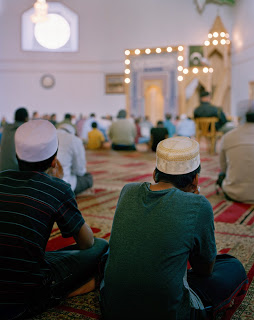| Online: | |
| Visits: | |
| Stories: |

| Story Views | |
| Now: | |
| Last Hour: | |
| Last 24 Hours: | |
| Total: | |
In God's House (Part I): An Early Look at a New Documentary in American Religion
Today's guest post comes from Barton Price. Barton is the Director of the Centers for Academic Success and Achievement at Indiana University-Purdue University, Fort Wayne (IUFW). Earlier this month, he attended the American Society of Church History's spring meeting where he had a chance to watch an early screening of In God's House: The Religious Landscape of Utica, NY, a documentary directed by Robert Knight and produced by S. Brent Rodriguez-Plate. Here he shares his experience. Later this week we will get a behind the scenes look from Brent Plate.
Barton Price
In God’s House tells the story of Utica, New York, a town in the Burned-Over District smoldering along the Rust Belt and reignited by ethnic and religious pluralism in the past two decades. The city and the surrounding county has become home to a number of refugees from Myanmar and Bosnia, adding to the religious diversity of the area. Along with these social veneers come new layers usage for religious spaces. For example, a United Methodist church building near city hall has become the Bosnian Islamic Center and a former Episcopal church building now houses a Vietnamese Buddhist congregation. Burmese people attend either the Bosnian mosque, the Buddhist temple, or an American Baptist church, depending on their religious identification. Meanwhile, Reformed and Conservative Jewish congregations share one building while declining to merge. The former Conservative synagogue is now a rehabilitation and nursing center.
 |
| Jummah prayer at the Bosnian Islamic Association of Utica mosque (former Central Methodist church). Photo by Robert Knight |
The filmmakers were intrigued by the usage and reappropriations of physical spaces for new worship purposes, and this theme is the bulk of the film’s narrative. They juxtapose photographs of a building’s original usage with video of its new uses. At times, the new residents reoriented space within the building. For example, Muslims in the former Methodist church installed carpet whose lines are diagonal from the floorplan in order to orient congregants toward Mecca during prayers. Buddhists placed the altar to their bodhisattva near the center of the former Episcopal sanctuary. Viewers may find equally fascinating and subtly expressed how new residents repurpose other material objects. The Buddhists kept some of the pews for children to sit and observe their parents or grandparents chant prayers. The wooden boards in both the Methodist and Episcopal sanctuaries that once displayed hymn numbers now hold religious imagery for the respective Muslim and Buddhist congregations.
One theme in this film is the varied reactions to the shifting religious landscape in Utica. Conservative Jews expressed remorse that they had to leave their beloved synagogue nearly ten years ago, and see the decline of their congregation as a sign of secularization. Their Reformed hosts are more optimistic about intrafaith cooperation. Both the imam of the Bosnian Islamic Center and a priest at the Vietnamese Buddhist temple were very optimistic about their inclusion in Utica specifically and America generally. Mainline Protestants took the most alarming position, having a calm acceptance of the Mainline decline and embracing the plurality in Utica. One Presbyterian minister joked that the Mainline had become the sideline while a Baptist minister stated that he expected Burmese Christians to take over leadership of the congregation within ten years.
All of these changes to historic churches and its congregations reflect broader social and economic changes. The Mainline abandonment of its church buildings says as much about urban decay, white flight, and economic recessions as it does about pluralism.
Viewers asked the producer why the documentary excluded Roman Catholic parishes. The producer explained that despite repeated attempts to invite the parishes to participate, priests had not returned their calls. There are a few scenes of an AMEC church, but no sustained development of the African American community.
Admittedly, the documentary awaits post-production to smooth over many of its rough edges. However, it is an illuminating and engaging film that invites the professor to engage a class in discussion about its many themes.
A Group Blog on American Religious History and Culture
Source: http://usreligion.blogspot.com/2015/04/in-gods-house-part-i-early-look-at-new.html



